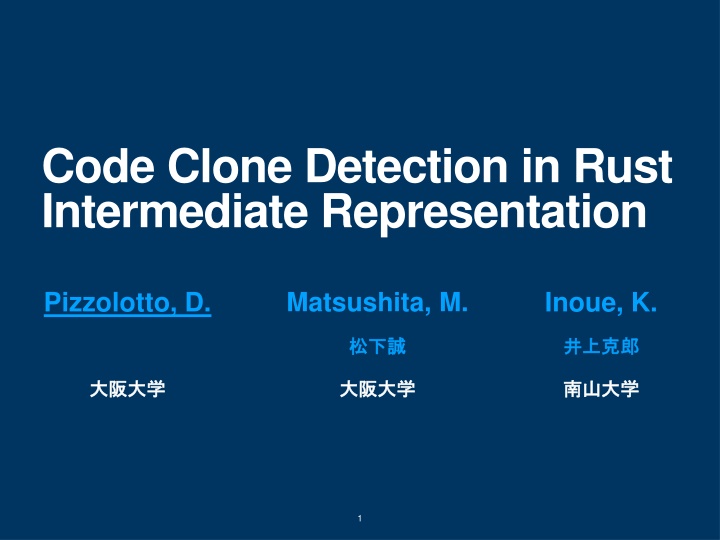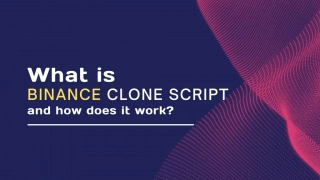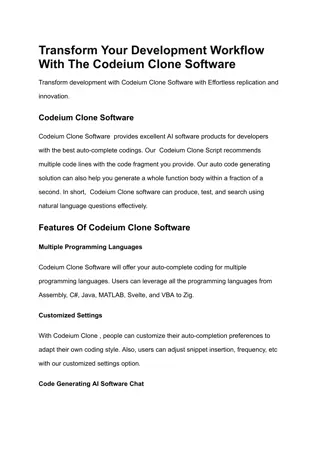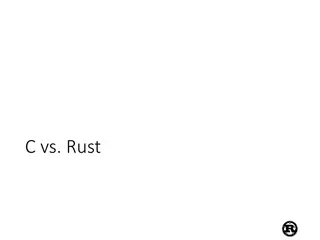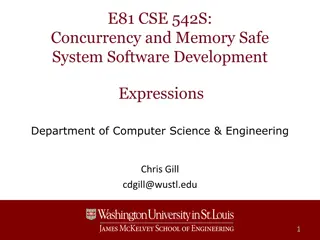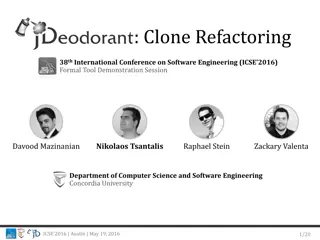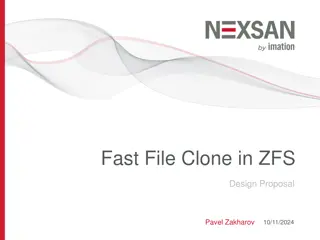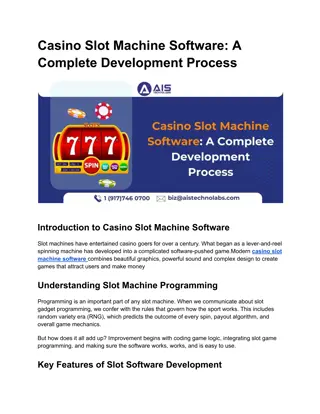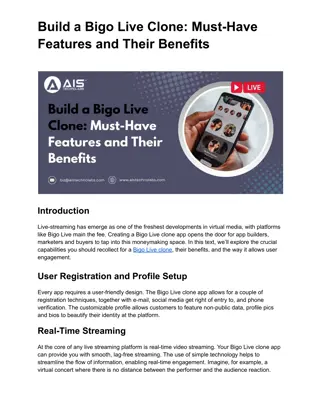Code Clone Detection in Rust Intermediate Representation
Code clone detection in Rust focuses on analyzing clones at Intermediate Representation level to compare differences between original source code clones and IR clones. This approach aims to identify additional clones through normalization in a modern language like Rust with compiler restrictions and safety features. Explore how Rust's design influences code clone detection strategies.
Uploaded on Feb 16, 2025 | 2 Views
Download Presentation

Please find below an Image/Link to download the presentation.
The content on the website is provided AS IS for your information and personal use only. It may not be sold, licensed, or shared on other websites without obtaining consent from the author.If you encounter any issues during the download, it is possible that the publisher has removed the file from their server.
You are allowed to download the files provided on this website for personal or commercial use, subject to the condition that they are used lawfully. All files are the property of their respective owners.
The content on the website is provided AS IS for your information and personal use only. It may not be sold, licensed, or shared on other websites without obtaining consent from the author.
E N D
Presentation Transcript
Code Clone Detection in Rust Intermediate Representation Pizzolotto, D. Matsushita, M. Inoue, K. 1
Code clones detection State of the art Code clone detection has been an actively researched topic and a large number of tools have been developed However, almost every tool focus on Java language, or C language. Lower-than-source level has been tried in a limited way only for Java code and LLVM IR, and most efforts are shifted in detecting type 4 clones rather than improving existing detectors. 2
Problem definition Is it possible to detect additional clones due to normalization, by checking lower stages of the compilation pipeline? Instead of targeting Java or C we try a modern language with an higher number of compiler restrictions Instead of analyzing clones at source level, we try analyzing at Intermediate Representation, in particular after desugaring and normalization We then compare differences between the original source code clones and the Intermediate Representation clones. 3
Background rust-lang Language developed by the Mozilla Foundation Designed around safety Compiler guarantees the absence of data races, guarantees type safety and guarantees the absence of invalid references Requires additional syntax from the programmer, that may introduce additional clones 4
Background Lifetimes // This struct has one lifetime // parameter, 'src struct Config<'src> { hostname: &'src str, username: &'src str, } The compiler needs to know when it is safe to drop a reference to memory In this case the lifetime src is used by the programmer to tell the compiler that the struct Config can not live longer than hostname and username 5
Background Mutability let mut a = Point { x: 5, y: 6 }; a.x = 10; let b = Point { x: 5, y: 6 }; b.x = 10; // Error: cannot assign to immutable field `b.x`. To avoid data races, Rust allows a single mutable reference or multiple immutable references to the same variable The compiler is highly conservative and may force the programmer to use mutexes or runtime checks. 6
Background Compilation structure In order to enforce the compiler constraints, several transformations are done to Rust source code during compilation These transformations relax some constraints and may reveal additional code clones that were missed at source level due to strict compiler rules 7
Background Compilation structure In our work we focus mainly on HIR 8
Background Compilation structure In our work we focus mainly on HIR HIR involves the following normalizations: parenthesis are removed if let syntax is normalized into match syntax for and while normalized into loop syntax additional contraints are relaxed 9
Approach Overview 10
Approach Macros 11
Approach Macros Invoke macro at compile time 12
Approach Macros 13
Approach Macros Generated by macros, we need to filter these methods before running the clone detector 14
Evaluation Research Questions RQ1, type: What type of clones can be usually found in a Rust project? Can the clones be easily refactored? RQ2, agreement: How different are the clones between original code and HIR? What type of clones are detected only by one method? RQ3, accuracy: How accurate is the clones detection in both original code and HIR? How many false posi- tives are generated by the code? 15
Evaluation Case Studies 16
Evaluation RQ1: Type 3033 clones in 15 rust projects: manual implementation of the method len or print for a specific class, copy pasted everywhere. different number of parameters for the same function. Instead of calling a more generic function, the body is copy pasted. A lof of functions marked as #[test] and #[bench]. Rust allows mixing test and benchmark code. 17
Evaluation RQ2: Agreement Number of clones is essentially increased sometimes by a factor of 1000. Most of these clones were due to custom build scripts or procedural macros that we failed to filter. 18
Evaluation RQ2: cgmath and ndarray Clone map shows clustered clones for both cgmath and ndarray. These are mainly due to procedural macros that we did not filter. In particular, in cgmath they represent the matematical operations for each class (Vector2, Vector3, Vector4 ) 19
Evaluation RQ2: agreement In all instances, the amount of line of codes in the HIR version is lower than the original. Compiler removes useless methods and boilerplate code including #[test] and #[bench] functions These clones, reported in the original code are thus not found in the HIR clones 20
Evaluation RQ3: accuracy We analyzed all clones in original source code and some randomly selected HIR code and could not determine any false positives However, most of the clones detected are not refactorable. 21
Evaluation RQ3: accuracy Reported as clone in the HIR, due to the increased number of tokens 22
Conclusion We analyzed the clones of 15 different Rust projects both in source code and High-level Intermediate Representation Most clones at source level are due to implementation of common methods such as len for multiple classes. In HIR code, most useless clones such as tests or benchmarks are removed, but a lot of clones may be added due to procedural macros. Although some new clones can be found, correctly filtering the macros requires high effort 23
